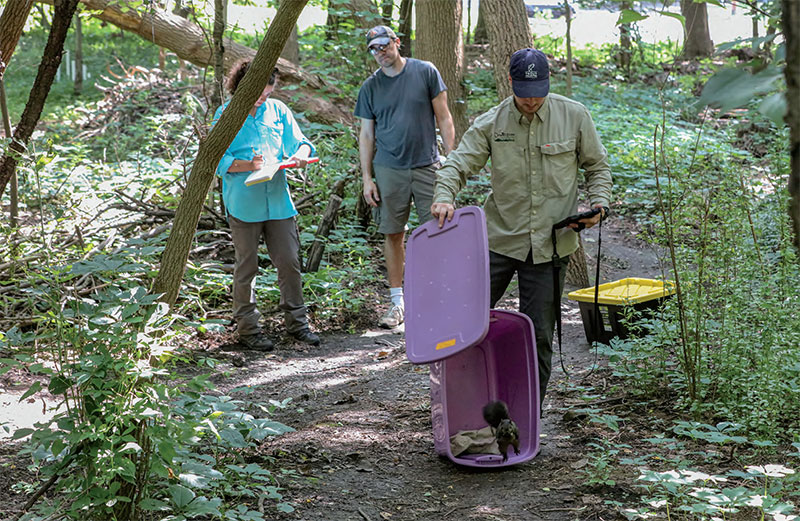The Pulteney StreetSurvey
UP CLOSE AND PERSONAL: NEW PERSPECTIVES ON STEM
Tools of the trade.

Among other equipment, trapping and tracking squirrels for the project required binoculars (1); radiocollars (2), which broadcast a unique radio signal specific to each squirrel; ear tags, which are marked with numbers unique to each squirrel and attached with pliers (3); and sample tubes (4) to store ear tissue for genomic analyses.
Tracking environmental change.

Guided by Associate Professor of Biology Brad Cosentino, Mark Suchewski ’22 releases a melanic eastern gray squirrel while Regina Hashim ’24 records data associated with the release location.
With student researchers, Cosentino and colleagues from Yale University and the SUNY College of Environmental Science and Forestry have been studying eastern gray squirrels and the ways cities shape their evolution. Supported by a National Science Foundation grant, the project relies on the data they collect from individual squirrels, as well as data submitted by K-12 students and thousands of citizen scientists from cities across the region. Like Cosentino’s other work, the research explores how environmental change affects the ecology and evolution of wildlife populations — a key area of study amid rapid urbanization and a changing climate.
Eastern gray squirrels, as the project abstract notes, “provide an ideal model system for exploring the different ways urbanization affects evolution.” Gray squirrels are generally gray or black (melanic); the latter, once common in forested areas, are now most prevalent in cities. To understand why, the project looks at how coat color affects squirrels’ antipredator behavior or susceptibility to vehicular collisions in cities.
Led by Cosentino’s former postdoctoral associate John Vanek, Suchewski and Hashim trapped squirrels of each color morph in city parks in Syracuse and collared each with a radiotransmitter to test whether the fitness of gray and melanic color morphs differs in urban and rural environments. The results so far suggest that natural selection is behind the prevalence of the gray morph outside the city, but Cosentino notes that the research team is “following up with additional studies to understand the mechanisms of adaptation, which focus on predation and human hunting. We think this is a neat example of a selection pressure, specifically predation and human hunting, becoming relaxed in cities, which allows the melanic color morph to thrive. Cities often have negative effects on biodiversity, but our work shows cities can maintain rare phenotypic traits in populations that might otherwise be lost.”
